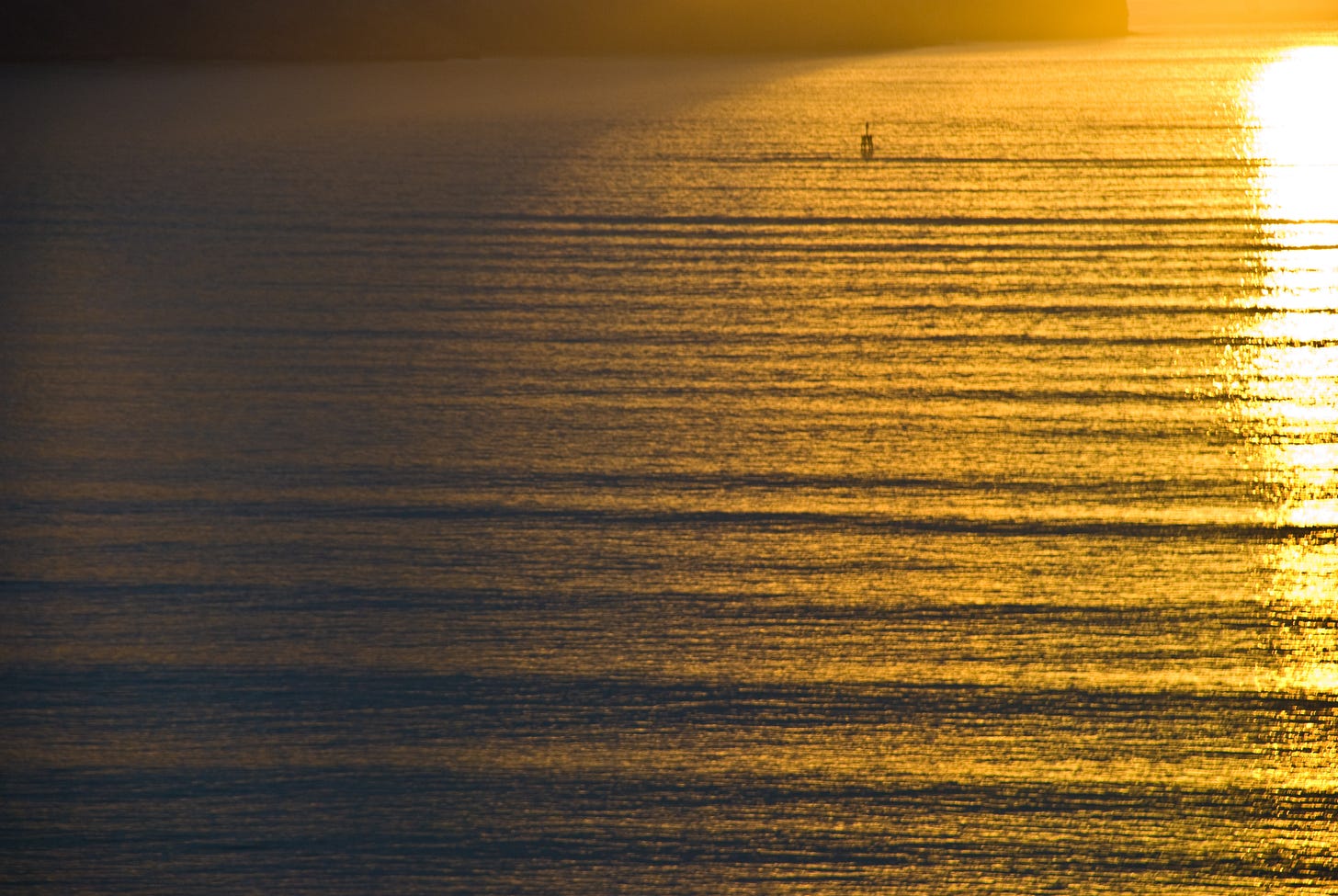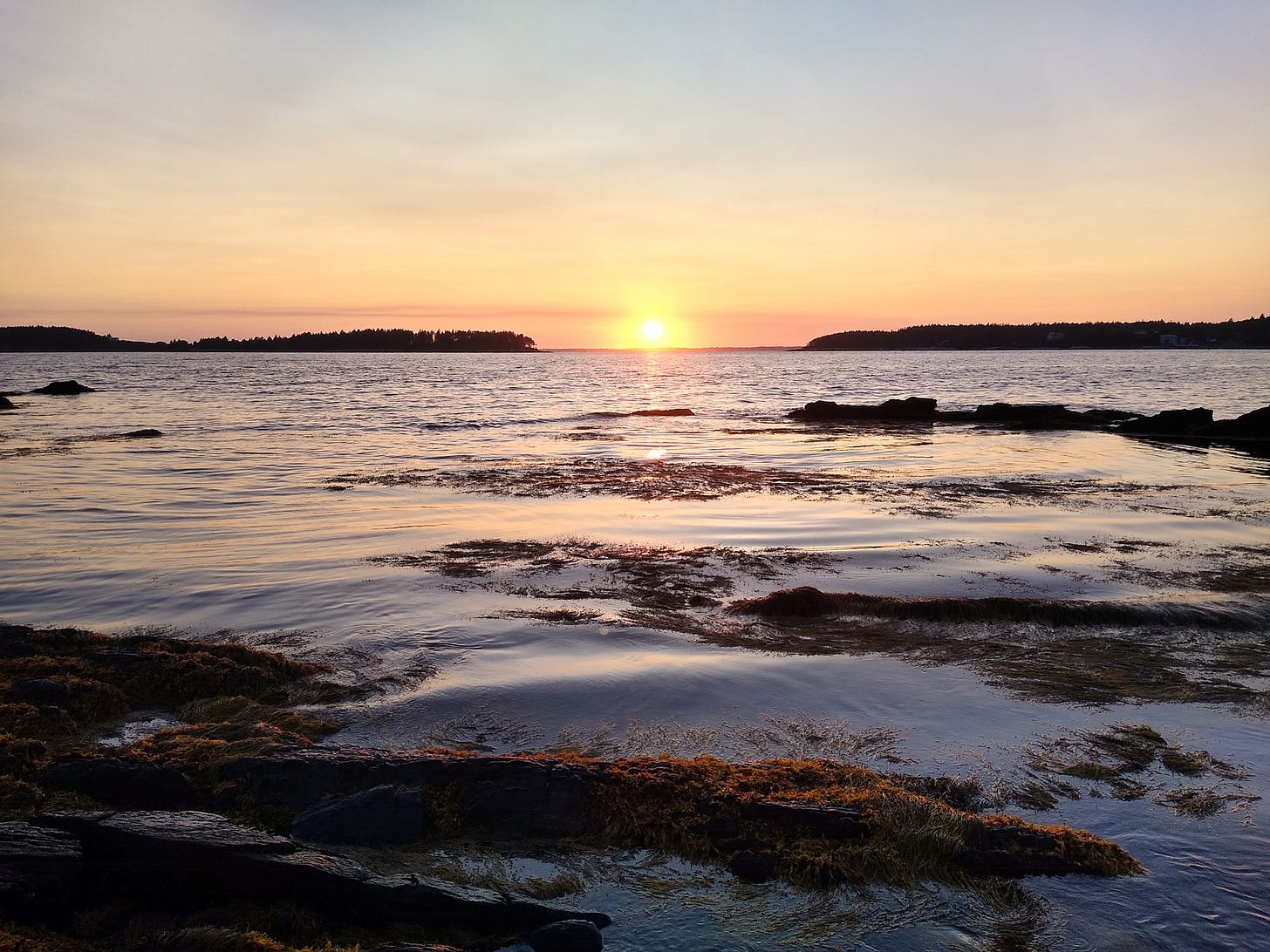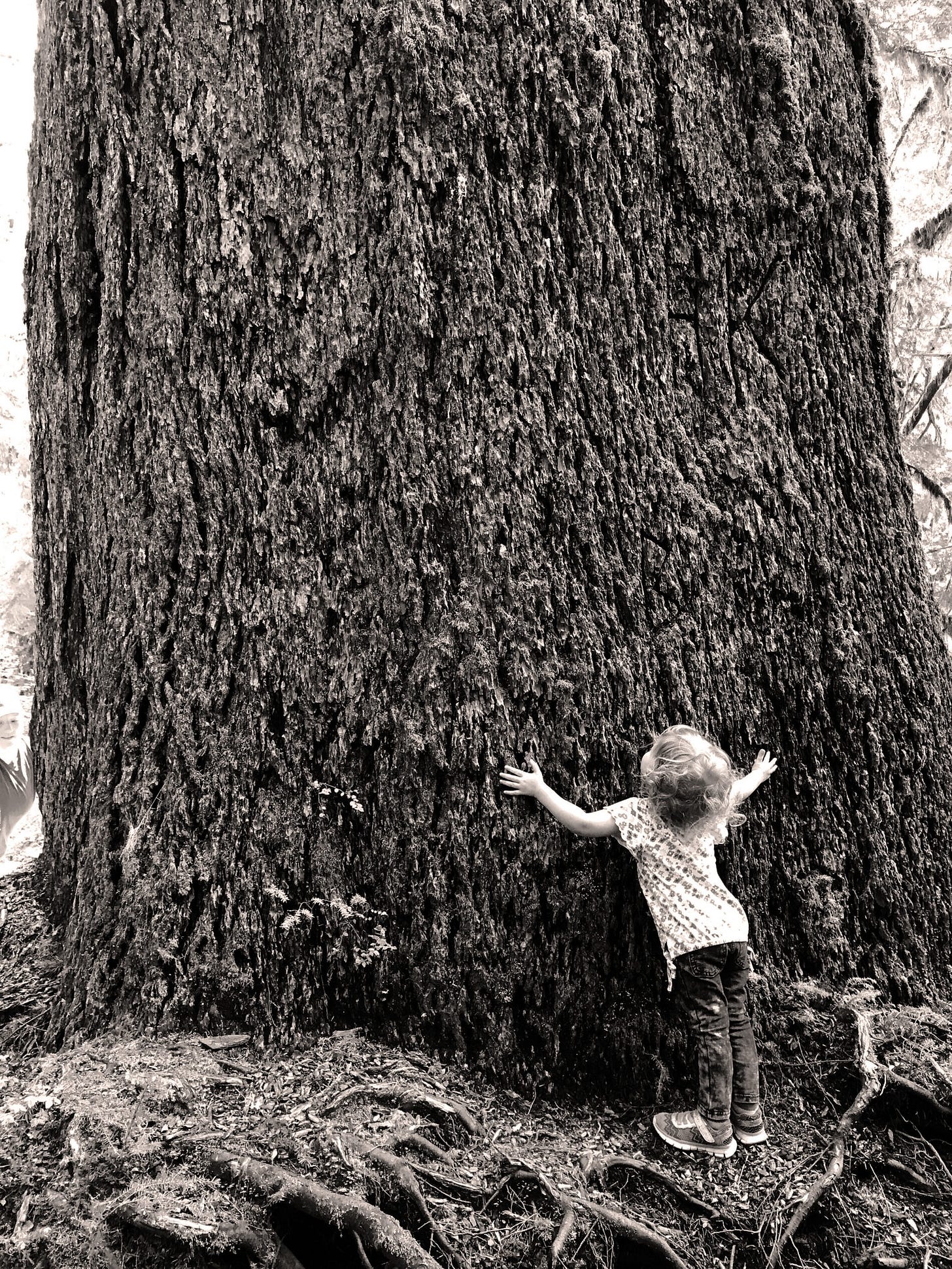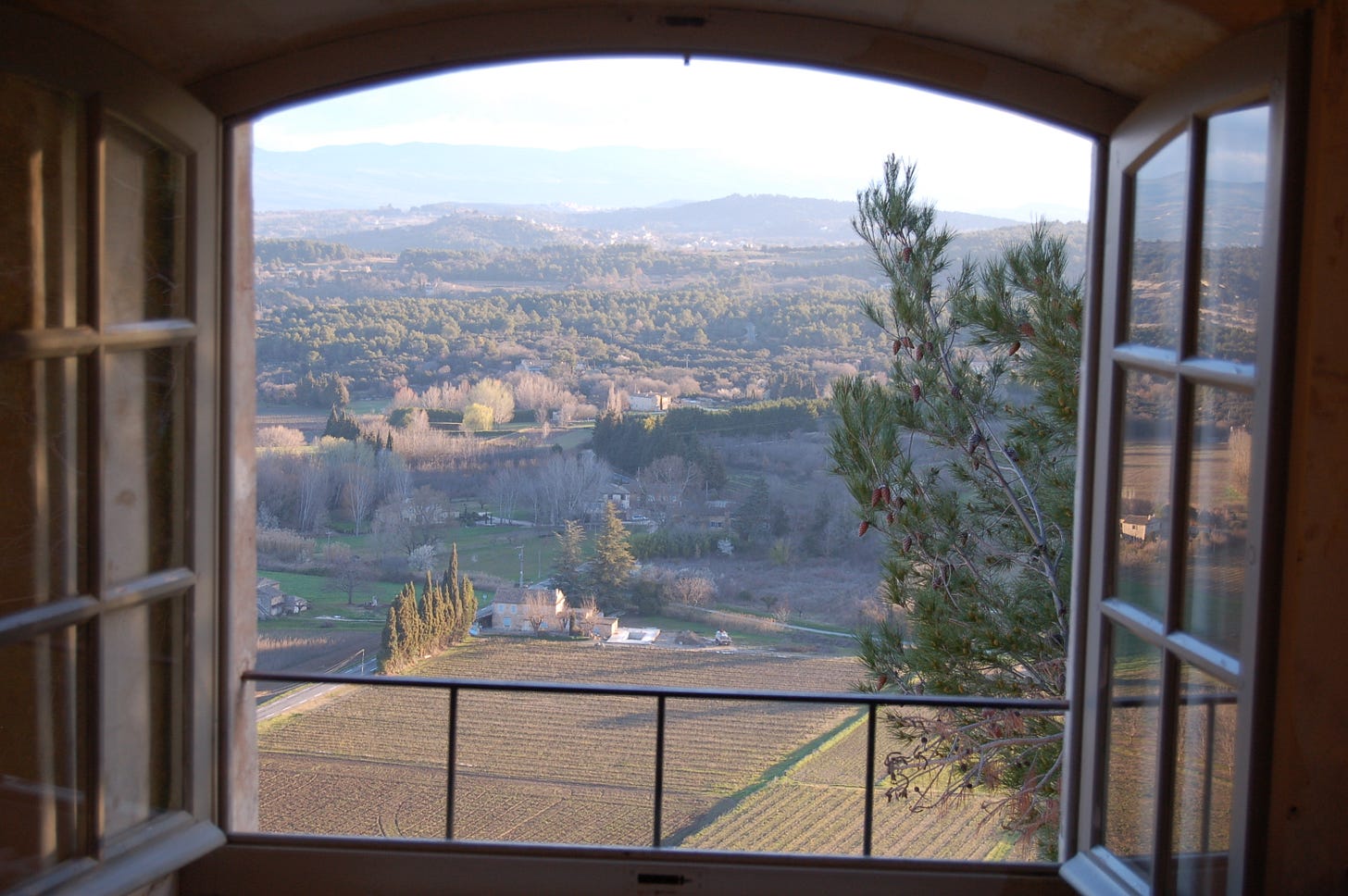Waves and the Fabric of Life
9/19/24 – Shortsightedness, farsightedness, and the Anthropocene
Hello everyone:
As always, please remember to scroll past the end of the post to read this week’s curated Anthropocene news.
Now on to this week’s writing:
One of the joys of spending time outside is catching glimpses of the invisible made visible. We’re surrounded by forces and patterns of physical energy that we’re blind to, until, suddenly, we're not. Most often this means watching the wind whisper from tree to tree, its story passed from one leaf to the next. Or perhaps a gust sweeps like a cat’s paw across the surfaces of water and tall grass. The glimpses are everywhere: heat ripples the air or conjures up a Fata Morgana, heliotropic plants take in more photons as they turn with the sun, and hawks rise in circles on thermals of earth-warmed air. All around us, what seems empty is beautiful and busy.
My friend Josh once described seeing swirls at the water’s surface caused by a fish and then thinking about the multitude of forces swirling through the already restless sea in the wake of billions of fish. He and I also talked about the difficulty of remembering that ocean waves are energy moving beneath the sea’s skin rather than traveling bodies of water.
We’re likewise bathing in oceans of invisible energies both natural and anthropogenic from the Sun, quasars, Earth’s magnetic field, our own electrical fields, radio and TV transmissions, cell towers, and much more. Our abundant VLF (very low frequency) radio transmissions are actually pushing back the Van Allen radiation belts that surround the Earth.
All of this reminds me of a primary lesson to be learned from the community of life: all matter is borrowed energy, and all energy is in motion. Our bodies are as ephemeral as clouds. The birds migrating overhead on these cool September nights are made of insects and berries. Death becomes life as the thriving communities we call soil surge upward into plants and then farther along the chain of borrowed energy - herbivore, carnivore - before returning home. All that we think of as “things” are really more verbs of being than nouns. Transience and permanence are synonyms.
When I talk about invisibility here, I mean invisible to us. Despite our transformative power as a species, as individual primates we’re still quite limited in our perception. These limitations are articulated nicely in Ed Yong’s great book, An Immense World: How Animal Senses Reveal the Hidden Realms Around Us. Yong is a science writer at the Atlantic, and writes in An Immense World about the myriad beautiful ways other species perceive aspects of the world – magnetic fields, infrared light, and whole territories of smell, touch, and sound - which are unavailable to us.
We can measure the sensitivity of a dog’s nose but cannot perceive it. We know that albatrosses and petrels map the wide open oceans with incredible sensitivity to magnetic fields and smell, but we cannot read those maps. (Read Adam Nicolson’s excellent The Seabird’s Cry to know more.) And there are still countless amazing daily phenomena around us we don’t fully understand, either intuitively or scientifically. I’m thinking of the migrations of eels and Monarch butterflies, the “symbiotic poetry of fungi partnering with trees to make clouds,” the dark and glacial pace of existence on the ocean’s abyssal plains, and so much more.
Yong explains that the species-specific worldview based in each creature’s set of perceptive abilities is called its umwelt (“self-centered world”), and the human umwelt is just one among many. The great natural history writer David Quammen wrote in a review that An Immense World is “a fascinating reminder that most of what happens among life forms on Earth is beyond our ken.”
We simply don’t sense as much of the real world as we think we do. At this point in human history, this is also due to our ecological amnesia, the result of each generation spending less time foraging for food, hunting and fishing, climbing trees, lying in tall grass, struggling up mountains, playing in streams and tidepools, wading through wetlands, or simply sitting for hours in nonhuman environments and paying attention in the way we did for the last million years.
Most of us are now urban/suburban, overworked, indoor, TV/YouTube/TikTok-watching creatures of the couch. We don’t see the depth and speed of our changes to the real world because we aren’t often in the world. Increasingly, too, there’s less of that world to see.
As couch-bound primates who only catch glimpses of a diminished reality, we’ve become increasingly dependent on our tools. By definition, our tools have always been more effective than we are, but now, as they evolve from extensions of our senses into containers for our cognition and our purpose, they’re becoming more important than we are too.
And so here we are in a transformed world, with our hyper-articulated intelligence embodied in technologies that exceed the dreams of our ancestors, but weirdly blind to the consequences of our actions. We suffer a large-scale failure to map into our daily lives that our civilizational experiment is causing an unsustainable surge of extinctions, pollution, climate change, and ecosystem collapses. In this sense, then, the increasingly obvious symptoms of the Anthropocene offer another example of the invisible becoming visible.
The good news, for those of us who want to exceed our sensory limitations, understand life more deeply, and work to repair our relationship with the living world, is that two of our species’ most important tools – science and writing – continually make visible the hidden realms. Thus Ed Yong’s book, and thus the thousands of scientific papers coming out daily that reveal more and more of the nature of nature. And thus this Field Guide, which relies on the research and dedication and empathy of a vast network of open-eyed observers seeing what is real and true about the world and its transformation.
It’s worth remembering once in a while, though, that as much as science is a remarkable extension of our sensory apparatus it is also a reminder of how limited that apparatus is. In doing so, we recognize the animal we have always been.
I’ve often imagined our capacity for perception - our umwelt - as the equivalent of looking out at the entire world through a single window. We are limited by the frame we forget is there. Ironically, this metaphor betrays the human emphasis on sight (within a narrow segment of the light spectrum) in how we understand the world.
The combination of our physiological shortsightedness and our scientific farsightedness is at the root of the Anthropocene and our catastrophically slow response to it. For the last few hundred years, and especially the last century, looking through our narrow window we wanted what we wanted and we were clever enough to apply scientific rigor to our desires, heedless of the costs.
This narrow and self-serving civilizational dogma - the world outside the window belongs to us - has been so comprehensively accepted that even the most ecologically-minded of us are hesitant or unable for practical reasons to give up many of our harmful behaviors. I often think that from the perspective of most other species science has been less a miracle humans have invented and more a weapon we’ve wielded. It’s the force behind our unrelenting set of waves knocking down forests and churning beneath the skin of the blue and green worlds.
Like it or not, we are living through a crucible of human history. Still in the early centuries of the Anthropocene, we’ve diminished much of the green world and lit a fossil-fueled eternal flame under the planetary kettle. With an absurd amount of resource use, a population growth more like that of bacteria than primates, and a blind obsession with technologies which are as destructive as they are creative, we’ve created in the blink of an eye a new era whose signature will still be written in stone millions of years from now.
Which means that this crucible of human history is more importantly a crucible of Earth history, because despite centuries of pretending that we are somehow above the biological fray, we now find ourselves cooking in the kettle along with all of our fellow species. The difference between us and them – one of the very few, as it turns out – is that we alone evolved the cognitive capacity to reimagine the world for our purposes and the physical ability to bring those self-serving dreams to reality.
The world, quite literally, will never be the same. How different it becomes is entirely up to us.
We know what we need to do, but the waves of Earth-focused empathy and discipline moving through the fabric of global culture are still not strong enough to turn the tide.
The world is still beautiful and busy, and much of what we love in it is still often invisible to us. In fact, in that mystery lies much of the beauty. In our bodies, and in our societies, we’re still only a process among a planetary network of processes.
As I type these last words, I hear the night wind shaking the oaks to remind them to drop their borrowed energy - in the shape of acorns - down to the forest floor. Birds full of berries are riding the wind southward. A light fog brings moisture in from the sea while faint stars send ancient photons through the darkness to our heliotropic Earth.
Transience and permanence are still synonyms, but this crucible of human and Earth history is changing their definition. We’ve altered the flow of energy and co-opted its storage for matter of our own making. As a result, there are fewer fish roiling the sea and fewer hawks riding the empty thermals, but we can fix that. There are many people already doing the good, hard work of realigning our actions with the needs of the real world. The rest of us simply need to see what we’re missing, and take joy in making it visible.
Speaking of joy: Last night, just before I joined a group of several dozen teens around a seaside campfire to read from my writing and talk about the world as it is, I found these waves, first in conflict with each other, and then unified in their gentle sweep toward the shore.
Thanks for sticking with me.
In other Anthropocene news:
From MIT Technology Review, an overview of the disturbing developments in H5N1 “bird flu” spreading through dairy herds in the U.S. This is not just an American story of authorities not being vigilant or active enough to slow a terrible virus. This is a story of global consequence because too little vigilance here will have long-term impacts on populations of domestic animals, wild animals, and humans everywhere.
Two important pieces from
: In a piece titled “Silent Solar” from his newsletter The Crucial Years, McKibben offers some really extraordinary good news about the under-reported explosion of solar installation transforming the developing world. And in the Guardian, he lays out the climate consequences of a 2nd Trump term:If we elect Donald Trump, we may feel the effects not for years, and not for a generation. We may read our mistake in the geological record a million years hence. This one really counts.
In related news from the
newsletter, a 2nd Trump term would include (per Project 2025) the deregulation of PFAS “forever” chemicals, which are wreaking havoc in communities across the country.And two pieces on the incredible work the Biden/Harris administration has done (and is still very much doing) to invest in and accelerate the clean energy economy: From
at his Volts podcast, an interview with a key Biden economic advisor on just how much has been accomplished. And from Axios, a brief summary of the sprint to the finish line for the Biden/Harris administration as it looks to spend as much of the multi-billion dollar funding available for clean energy projects as possible. The more money they can get out the door, the less a prospective Trump administration will be able to claw back or otherwise eliminate.In another Biden/Harris administration announcement, NOAA has released the final environmental impact statement for the proposed Chumash Heritage National Marine Sanctuary off the California coast. The sanctuary will be managed for biodiversity conservation by both NOAA and Indigenous communities, and will extend along 116 miles of CA coastline and cover an area of more than 4500 square miles.
From Inside Climate News, good news for the most endangered bird in the U.S., the Florida grasshopper sparrow. A careful but experimental breeding program has successfully increased the population to 200 individuals, providing hope that continued efforts will ward off extinction.
Likewise, from the Times, some good news in the long effort to save North American bats from white nose syndrome, the introduced fungus that has decimated colonies and populations. Scientists are applying a variety of strategies, like spraying hibernacula (winter roost sites) with a chemical that contains the fungal spores, keeping the hibernacula cooler to suppress fungal activity, building artificial roosting sites with ideal characteristics, and planting extensive wildflower meadows in cleared areas under nearby power lines to increase insect numbers. The results are allowing the researchers to feel, for the first time in many years, cautiously optimistic.
From
at his Climate Water Project newsletter, the third installment in his deep dive into the science of bioprecipitation. It sounds like a dense read, but it’s fascinating, particularly his discussion of terpenes, the organic molecules which form what he calls a “universal language” used by fungi, bacteria, animals, and plants, and which may play a significant role in regulating Earth’s climate.From
at her Sustainability by Numbers newsletter, an exploration of the costs of providing water at a global scale through desalinization.From Reasons to be Cheerful, the vast fleet of U.S. school buses is becoming electric, and the pace of change is accelerating. The buses are faster, cleaner, quieter, and much cheaper to maintain. Children and bus drivers no longer breathe the filthy exhaust of diesel engines. When plugged in, buses may become standby batteries for utilities to help power the grid. The Los Angeles school district has 56 electric buses already, with another 180 on the way:
These 180 electric school buses are expected to remove an estimated 780,000 tons of carbon dioxide from the environment per year. The district will also save a yearly average of $10,000 per bus in maintenance and fuel costs combined (depending on local electric rates, which fluctuate due to demand). That’s a total savings of nearly $2 million per year.
From the
newsletter, an excellent story of river restoration in CA, in which years of activism, hard work, community building, and more have brought a once ruined river back to life. Even the king salmon are showing up again. If you’re interested in well-written solution-focused journalism, consider subscribing to Earth Hope.










Thanks for this brilliant and important essay Jason. 👏 Always nice to see a tip of the hat to the extraordinary Ed Yong.
Your observations of our ecological blindness and tech powers calls up this observation by EO Wilson:
"The real problem of humanity is the following: We have Paleolithic emotions, medieval institutions and godlike technology. And it is terrifically dangerous, and it is now approaching a point of crisis overall."
I am new to your Substack. This is the first article of yours that I’ve read, and I am blown away. Thank you so much.